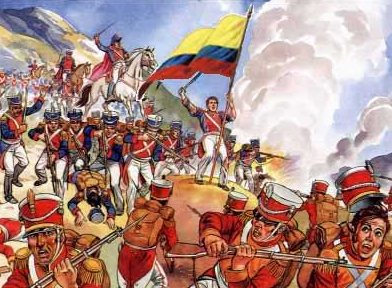Victory at the Battle of Tarqui in 1829 meant that Cuenca is Ecuadorian and not Peruvian
By Sylvan Hardy
Had it not been for a handful of 1829 battlefield decisions, Cuenca could well have been a Peruvian city today. Historians say the outcome of the Battle of Portete de Tarqui could have gone either way.

An artist’s glorified version of the Battle of Tarqui.
On Friday and Saturday, Ecuador’s victory at Tarqui was celebrated in Quito, Cuenca and Portete de Tarqui. President Lenin Moreno attended Ecuador’s biggest annual military parade in a rainstorm in Quito while Mayor Marcelo Cabrera presided over an announcement of the establishment of a military museum in Cuenca. Other events were held at the site of the battle, 15 miles south of Cuenca, including a Friday performance by the Cuenca Symphony Orchestra.
Although the victory at Tarqui is considered the founding event of Ecuador’s armed forces, the winning side, in fact, fought under the flag of Gran Colombia, the short-lived dream of Simon Bolivar that combined present-day Ecuador, Colombia, Panama, Venezuela and parts of Brazil. Bolivar appointed Antonio José de Sucre to lead Gran Colombia against the Peruvian army led by Peruvian president José de La Mar.

Ecuadorian special forces troops in Saturday’s military parade in Quito. (El Comercio)
La Mar, who was born in Cuenca, was intent on annexing southern Ecuador, including Cuenca, Guayaquil and Loja, into Peru. At the time of the Battle of Tarqui, La Mar’s forces occupied most of the area south of Cuenca.
Historians say that, over the years, official descriptions of the battle have been exaggerated and glorified with less glamorous details being omitted. Instead of an army of Gran Colombia, it was more accurately an army of Cuenca, a rag-tag force of local conscripts, most of whom knew or cared little about the issues at stake. The battle itself ended in stalemate, with each side claiming victory. The final outcome, which established today’s border between Ecuador and Peru, was determined by agreements signed in Giron, just south of the battlefield, and in Piura, Peru.
One of the messier details of the battle, according to Cuenca historian Juan Cordero, was the fact that 20 percent of Gran Colombia’s 5,000 soldiers deserted prior to or during the battle. For months afterward, firing squads executed as many as 200 suspected deserters in Cuenca’s San Francisco Plaza and today’s Parque Calderon.
Following agreements in Giron and Piura, La Mar withdrew his troops from present-day Ecuador. Within months, his government in Lima was overthrown and he was forced into exile in Costa Rica where he died a year later.
The Gran Colombia coalition fell apart two years after the Battle of Tarqui, and Ecuador, with Cuenca within its borders, became an independent country.





















